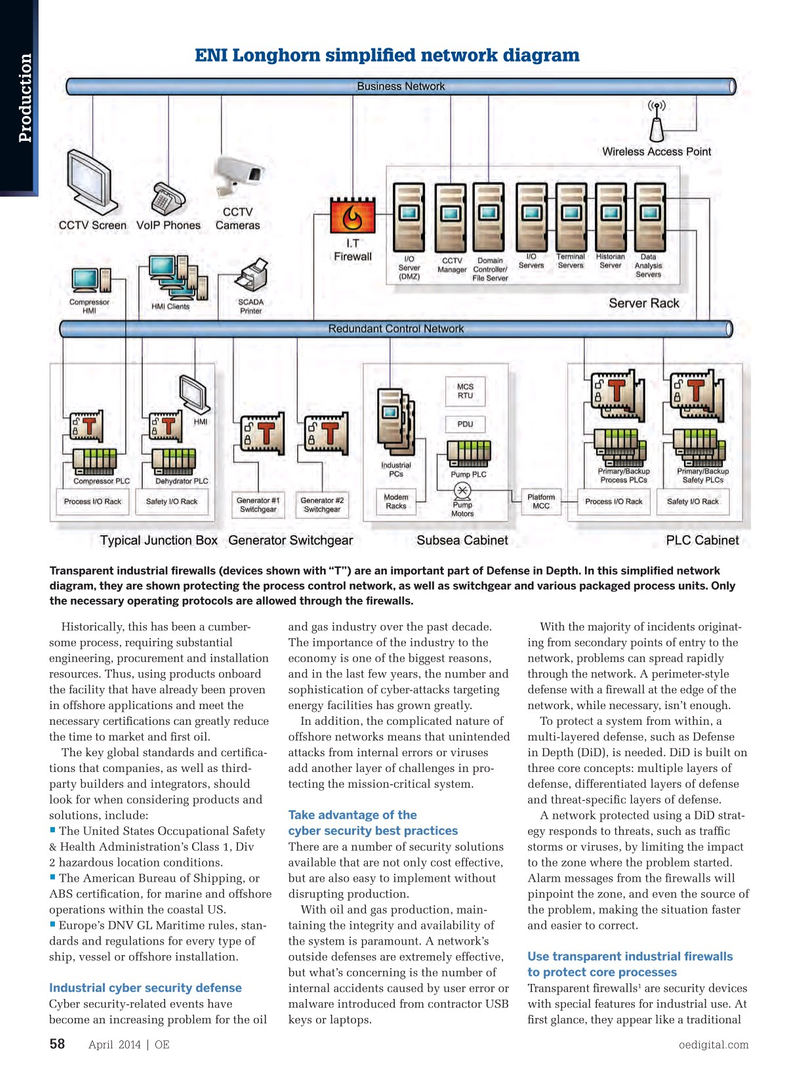
Page 56: of Offshore Engineer Magazine (Apr/May 2014)
Read this page in Pdf, Flash or Html5 edition of Apr/May 2014 Offshore Engineer Magazine
ENI Longhorn simplifed network diagram
Production
Transparent industrial frewalls (devices shown with “T”) are an important part of Defense in Depth. In this simplifed network diagram, they are shown protecting the process control network, as well as switchgear and various packaged process units. Only the necessary operating protocols are allowed through the frewalls.
ONSHORE. OFFSHORE. Historically, this has been a cumber- and gas industry over the past decade. W ith the majority of incidents originat- some process, requiring substantial The importance of the industry to the ing from secondary points of entry to the network, problems can spread rapidly engineering, procurement and installation economy is one of the biggest reasons,
EVERY SHORE.
through the network. A perimeter-style resources. Thus, using products onboard and in the last few years, the number and defense with a frewall at the edge of the the facility that have already been proven sophistication of cyber-attacks targeting
Certi? cation | Training | Events | Standards | Statistics | Safety network, while necessary, isn’t enough.
in offshore applications and meet the energy facilities has grown greatly.
Washington, D.C. | Houston | Beijing | Singapore | Dubai | Rio de Janeiro necessary certifcations can greatly reduce In addition, the complicated nature of T o protect a system from within, a the time to market and frst oil. offshore networks means that unintended multi-layered defense, such as Defense 877.562.5187 (Toll-free U.S. & Canada) The key global standards and certifca- attacks from internal errors or viruses in Depth (DiD), is needed. DiD is built on tions that companies, as well as third- add another layer of challenges in pro- three core concepts: multiple layers of +1.202.682.8041 (Local & International) party builders and integrators, should tecting the mission-critical system. defense, differentiated layers of defense [email protected] | www.api.org look for when considering products and and threat-specifc layers of defense.
Take advantage of the solutions, include: A network protected using a DiD strat- cyber security best practices
The United States Occupational Safety egy responds to threats, such as traffc • & Health Administration’s Class 1, Div There are a number of security solutions storms or viruses, by limiting the impact 2 hazardous location conditions. available that are not only cost effective, to the zone where the problem started. •
The American Bureau of Shipping, or but are also easy to implement without Alarm messages from the frewalls will
ABS certifcation, for marine and offshore disrupting production. pinpoint the zone, and even the source of operations within the coastal US. With oil and gas production, main- the problem, making the situation faster •
Europe’s DNV GL Maritime rules, stan- taining the integrity and availability of and easier to correct.
dards and regulations for every type of the system is paramount. A network’s ®
Use transparent industrial frewalls ship, vessel or offshore installation. outside defenses are extremely effective,
It’s a tough business. Look to API.
to protect core processes but what’s concerning is the number of
Copyright 2014 – American Petroleum Institute, all rights reserved. API, the API logo, the “Onshore” slogan and the “Tough” slogan are either service marks, trademarks or registered trademarks of API in the United States and/or other countries.
1
Industrial cyber security defense internal accidents caused by user error or Transparent frewalls are security devices
Cyber security-related events have malware introduced from contractor USB with special features for industrial use. At become an increasing problem for the oil keys or laptops. frst glance, they appear like a traditional
OffshoreEngineering_HalfPageAd2.indd 1 2/10/14 10:36 AM
April 2014 | OE oedigital.com 58 000_OE0414_Prodops1_Belden.indd 58 3/22/14 9:59 PM

 55
55

 57
57